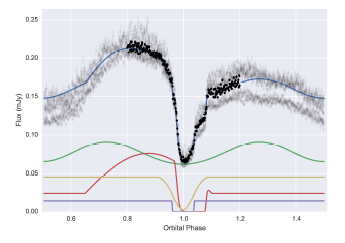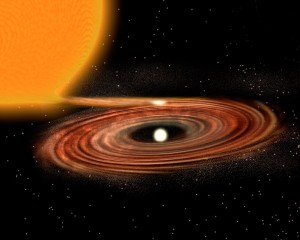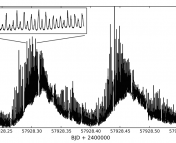Title: Discovery of an eclipsing dwarf nova in the ancient nova shell Te 11
Authors: Brent Miszalski, P. A. Woudt, S. P. Littlefair et al.
First author’s institution: South African Astronomical Observatory
Status: Accepted for publication in MNRAS

The nebula Te 11. Observations of the interacting star at its core suggest it may have been formed by a giant explosion, matching one spotted by astronomers over 1500 years ago.
On the 16th of November in 483 CE, astronomers in China recorded the appearance of “a guest star east of Shen, as large as a peck measure, and like a fuzzy star”. The new celestial light shone brightly for just under a month, then faded to nothing. Over 1500 years later, the authors of today’s paper may have found the source.
The suspect is a nebula known as Te 11, a cloud of expanding, glowing gas around half a light-year across at its widest point. Te 11 was originally thought to be a planetary nebula. These are, confusingly, nothing to do with planets, but are instead made out of material thrown off a red giant star as it shrinks into a white dwarf.
But although visually Te 11 looks like a planetary nebula, many of its characteristics don’t quite fit. It’s moving too slowly, and has much less mass than other, confirmed examples.
To search for alternative ways in which the nebula could have formed, the authors obtained a light curve, shown in the figure below, and spectroscopy of the object lurking in Te 11’s centre. They found a white dwarf, just as the planetary nebula hypotheses predicted. But it wasn’t alone.

Light curve of the dwarf nova at the core of Te 11, showing an eclipse of the white dwarf by its companion star. The purple, red, yellow and green lines show the contribution from the white dwarf, disc, a bright spot on the disc, and elliptical shape of the system, respectively, adding up to make the blue line.
The white dwarf is accompanied by an M dwarf star, so close together that they orbit around their centre of mass in less than three hours. At such close proximity, the gravity of the white dwarf draws material off its companion, forming a ring of gas known as an accretion disc. The material in the disc then gradually spirals down onto the white dwarf.

Artist’s impression of a dwarf nova. The gravity of the white dwarf draws material off the companion star, forming an accretion disc. Image: NOAA
In a number of these systems, the disc becomes unstable every few years, probably due to a change in the viscosity of the gas caused by a rise in temperature (no one is exactly sure how it works). The material falling onto the white dwarf briefly turns from a gentle trickle into a raging torrent, releasing huge amounts of gravitational energy as light. The regular mini-explosions give the systems their name: Dwarf novae, after the larger cosmic explosions called novae and supernovae.
The authors’ observations of Te 11 had been prompted by five novae-like events in the last ten years, spotted by the Catalina Real-Time Transit Survey. The new observations both confirmed that the system was a dwarf nova, and provided exact measurements of some of the characteristics of the two stars, such as their masses and radii.
Te11 hosts an was unusually massive white dwarf, 1.18 times the mass of the Sun (a typical white dwarf is around 0.6). This meant that, as well as dwarf novae, bigger classical novae could also occur. Classical novae take place when the mass building up on the white dwarf becomes so dense that the hydrogen begins to fuse, releasing huge amounts of energy and blowing apart the (newly added) outer layers of the star.
Such a high mass white dwarf means that a novae could reasonably have occurred recently, within a time scale of hundreds of years. The material from the novae would have slammed into the unusually dense interstellar medium in the area, creating the Te 11 nebula. The authors postulate that this huge explosion was the source of the “fuzzy star” spotted in 483 CE.
Miszalski et al. finish by suggesting that more novae could have occurred since then, and high resolution imagining might reveal shells of material nestled inside the nebula. Observing these would give unprecedented insight into the physics of novae and the structures they leave behind.





“…from a gentile trickle…”
So it’s not kosher, then? 😉
I actually remember looking at that sentence thinking “there’s something not right there…” Fixed now, thanks.
Hello David,
I have just one qestion regarding the figure with the light curve of the system.
How did the authors get purple, red, yellow and green curves? I suppose they had some kind of a model (?), but how did they convince themselves that the model was adequate enough?
Thank you for your time.
Andrija
Hi Andrija,
They use a method known as a Markov-Chain Monte Carlo, or MCMC. They randomly generated light curves for each element (disc, spot etc), which vary over what’s physically possible. They then made 400,000 different combinations of these random light curves and checked how well the combined light curve matched the data. They then picked the best combination, which is what you see in the plot.